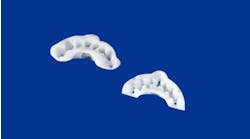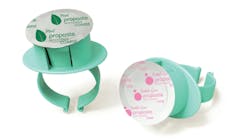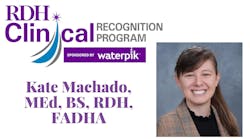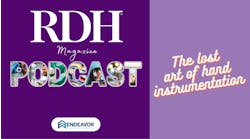Floss queen, toothbrush zealot, and rubber tip fanatic are just a few of the cutesy names patients have for their hygienist. We cringe or smile or even complain to our peers, but the truth is that we do labeling of our own. I have heard tales of the non-compliant, those darn anti-fluoridationists, and even problems with health nuts. The last being defined by a fellow RDH recently as those who don't serve milk to their children and eat grapefruit everyday.
Health-care professionals are provided with the opportunity to interact with individuals from all walks of life. How we choose to proceed and treat these fellow human beings is totally up to us – and your state practice act, anti-discrimination laws, etc.
Let's start with the non-compliant patient — who despite our best educational efforts will not floss, will not come in at the recommended interval, and on a really bad day will even refuse routine radiographs. Often, this person is also the clock watcher who “just wants a cleaning” because other obligations are waiting.
Sometimes we just do our best with such individuals and hope for the day when all our efforts come to fruition. As sad as this scenario may sound, it may be the best approach in many circumstances. Unless you have a close relationship with this particular patient, there is no way to know why he or she blocks all your suggestions. It is our job to examine, diagnose, treat and educate; the action taken is solely the responsibility of the patient.
In the past, I have brought in magazine articles, research sources and even the inspiring words of Dr. Oz to try and inspire the seemingly unmotivated individual. Usually the outcome was the same, “It's just a cleaning today, right? I'm in a bit of a hurry.” Keep educating and maybe months or even years later the rewards will become evident. You know the information has sunk in when the patient comes to you with something heard or read about oral disease and he or she wants to know more. It may be exactly what you have been saying forever, but smile and act interested anyway.
Radiographs
Refusing routine radiographs can be a source of frustration for many practitioners. The ADA and FDA have revised the guidelines for selecting patients needing radiographic examinations. The complete 2004 revision can be viewed online at http://www.fda.gov/cdrh/radhealth/adaxray-1.pdf. According to this document, which admittedly gives little specific instruction, “Radiographs should be taken only when there is an expectation by dentists that the diagnostic yield will affect patient care.” I could fuss about the inclusion of only dentists in this decision, but the powers that be still do not find the dental hygienist capable of diagnoses. (Another topic for another time.)
Patients deserve a reason for being exposed to radiation. The mere fact that our recommendation is questioned is not grounds for dismissal, but another chance for education. Of course, the education cannot be based on “we take X-rays every year on everyone.” More acceptance may come from describing interproximal decay and the difficulty in detecting it with a sharp metal instrument. Better yet, relate diet and xerostomia to higher risk for oral disease. Why practice cookie-cutter health care delivery when the guidelines suggest individualized plans?
Fluoridation
Anti-fluoridationist is a term I first heard in 2007 during an online discussion of water fluoridation. In my opinion, it is an ugly label for those concerned about public drinking water. It should also be noted that most of those opposed to water fluoridation are not seeking total elimination of the element. Topical fluoride and its benefits are seldom argued by these individuals. Instead of spending so much time invalidating their beliefs, health-care providers should open our ears and listen to the concern: then present evidence in a non-confrontational manner to support our own stand on the issue. If the patient's concern is based on spiritual or religious teachings, respect it and move on. With CPP-ACP technology readily available, we have other options to present for caries prevention.
Those opposed to water fluoridation do have some solid research to support their position. Coplin, Patch, Masters and Bachman published a study in the September 2007 issue of Neurotoxicology showing that children living in communities with silicofluoride-treated water experience elevated levels of blood lead at a rate nearly double to those living in non-fluoridated communities. Another reference in Clinical Oral Investigations supports the use of topical fluoride stating, “…the caries reduction directly attributable to water fluoridation have declined in the last decades as the use of topical fluoride had become more widespread…” This review was published in the September 2007 journal.
One interesting study was done by Maguire, et al, from the School of Dental Sciences in Newcastle, England. They measured fluoride intake and urinary excretion of fluoride and thus determined retention in children six to seven years old. They tested children living in fluoridated as well as low fluoride areas. The results showed no difference in retention among the groups and concluded that fluoride toothpaste ingestion contributes significantly to total fluoride intake. The author even includes an email address, [email protected], leaving the possibility of questioning the study open to everyone.
While there are undeniably more published works pointing to the benefits of water fluoridation than the dangers of such a practice, all studies deserve attention and scrutiny. Just like lead-based paint and asbestos, some health concerns are not investigated or known until long after a practice is in place and accepted.
Health nuts bring a whole new dimension to the practice of health care delivery. Imagine an entire society of people who seek out the best foods and healthiest lifestyles possible. We don't have to agree with every choice made by our patients, but I know we can learn more by asking questions than pointing fingers. I have no idea how eating grapefruit everyday makes a “nut,” but we are all entitled to opinions.
Milk intolerance in children is not new; I remember not being able to drink milk for most of my pre-teen years. A pediatrician who treated my older children recommended weaning from breast milk to soy — a concept not well accepted in our rural dairy community. While I did not follow his advice to avoid cow's milk for my children, we did heed his recommendations for alternative sources of calcium and added them to our diet. Calcium is readily available in sesame seeds, green leafy vegetables, and even figs. If a patient is opposed to ingesting milk, perhaps recommending alternatives is appropriate. Arguing about the practice will only sway the “nut” pendulum in the opposite direction.
We will never stop the titles bestowed upon us by patients and well-meaning others. I will forever be “Toothpicker” to many of my children's friends, and the one rubber-tip fanatic in my past wears her badge proudly. As professionals, we need to rely on science, experience and evidence rather than generalizations when dealing with human beings. Nothing has ever been accomplished by categorizing our patients; therefore, this is a call for an end to labeling.
About the Author
Lory Laughter, RDH, BS, divides her full-time clinical practice between general and periodontics practices in Napa and Sonoma in California. She is co-owner of Dental IQ, a continuing education provider. In her spare time, Lory enjoys writing, speaking, volunteering, and providing shelter to homeless pets. You may contact her at [email protected] or through www.dentaliq.net.





